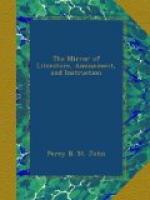crimson cloth of Bruges of that beautiful sort called
ecarlate. The boddice was drawn tightly
to her shape by rich gold cord, the ends of which,
finished by heavy tassels, fell downwards to the edge
of her robe. The crimson tunic reached only to
her knees, and discovered an under dress of white Syrian
silk, on which was a border of gold, evidently of
oriental workmanship. Her hard bust was covered
by many rows of the finest Asiatic pearls, and depending
from her girdle was a rosary of jet, which sustained
a richly embossed golden cross, probably enshrining
a piece of wood of the true cross from Palestine.
The small gold crown which circled her brows, and
the sceptre she held, were evidently made by the same
skilful artist—probably the work of the
celebrated Erembert, Abbot of Wansfort. Her arms,
which notwithstanding her towering statue were disproportionably
long, were covered by sleeves of the finest Bruges
linen, which however only appeared at the shoulders
and elbows, the rest of the arm being covered with
the crimson cloth which formed the tunic, and these
were laced with gold cord down to the waist, where
the Bruges linen formed a cuff. Her form was harsh
and bony, and no grace of motion relieved its outlines;
for she was so fearfully still, you might have thought
the living form had been placed in sight of the Gorgon’s
head and so transformed to stone. Her features
seemed alike immovable, all sunk into a dark, fixed,
and settled discontent with life.
* * * * *
THE BRITISH MUSEUM.
[This is the seventeenth volume of the Library of Entertaining Knowledge; and, like the majority of its predecessors, it aims at rendering popular, and of obvious interest, subjects which had hitherto been abstruse and uninviting. It is the first of a series of volumes to be published on the Antiquities of the British Museum, so as in some measure to set them free from their national imprisonment; for such we must term any assemblage of works of art (the property of the country), which are not unconditionally open to public inspection.
The portion before us is the first of two volumes devoted to the Egyptian Antiquities in the Museum. It has been diligently compiled; and rendered more interesting than would be a bare account of what the Museum contains, by correct notices generally “of the history of art among the Egyptians.” The best authorities have been consulted and acknowledged, as Hamilton, Heeren, Gau, and Belzoni, and the more recent labours of Mr. James Burton. The whole is attractively arranged in chapters; on the Physical Character of Egypt; Political Sketch of Ancient Egypt, and the monuments of the respective divisions of the country. We subjoin an extract, containing a graphic outline of Thebes:]
We pass by Kenneh, on the east bank, from which travellers may go to Cosseir to embark on the Red Sea; we hasten by the remains of Kouft, the ancient Coptos, and the solitary propylon of Kous, standing alone without its temple,—to the plain of Thebes, to the most wonderful assemblage of ruins on the face of the earth.




